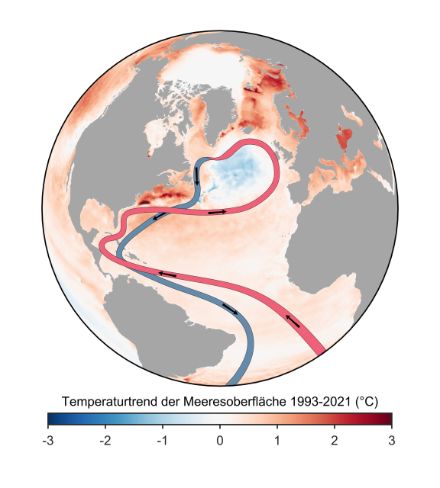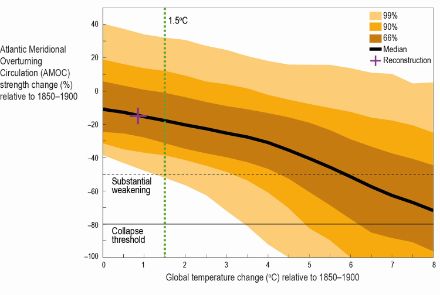Service Navigation
Search
Compared to similarly northern regions such as Canada or Russia, the climate here in Europe is significantly milder. In Scotland, for example, palm trees can grow where only mosses and lichens thrive at the same latitude in Canada. We owe this largely to the ocean currents in the Atlantic, the so-called Atlantic Meridional Overturning Circulation (AMOC), which also includes the Gulf Stream.
The AMOC transports warm water from near the equator to Europe. It is part of the even larger so-called thermohaline circulation, which spans the entire globe. In the North Atlantic, cold, salty water sinks into the deep ocean and draws in water from the south, which releases its heat into the atmosphere off Europe. It is important to note that only in winter the atmosphere tends to be colder than the ocean, such that the ocean can then release heat. The effect of the AMOC is therefore particularly important for the climate in the European winter.
How climate change influences the circulation
With climate change, however, two important factors in the regions of deep-water formation are changing, which are of decisive importance for this sinking:
- The air temperature: it rises, which means that the ocean can release less heat into the atmosphere. As a result, the water remains warmer and therefore lighter.
- The salt content: large parts of the Greenland ice sheet are melting. The meltwater flows into the sea. In addition, precipitation tends to increase due to the warmer atmosphere. Both effects lead to more fresh water flowing into the ocean, where it reduces the salinity of the water and thus also makes it lighter.
These factors ensure that less water sinks into the deep and the thermohaline circulation weakens, particularly in the North Atlantic. This in turn means that less of the salty water from the south reaches the North Atlantic. This can further weaken the current. Research has shown that it is possible that the circulation could become very weak or come to a complete collapse under certain circumstances. Reconstructions of past climate indicate that abrupt climate fluctuations during the last cold period were accompanied by strong changes in thermohaline circulation.
Consequences of a weakening circulation in the Atlantic
A slowdown of this circulation in turn has an impact on our climate. A reduced supply of warm subtropical water cools the North Atlantic. A cooling of the North Atlantic is already being observed today (see Figure 2). If the water is cooler, there will be less evaporation and therefore less precipitation over Europe.
The change in heat distribution can also influence large-scale weather systems, such as the Indian monsoon or precipitation over the Sahel zone. Furthermore, a weaker current along the east coast of America may lead to a rise in sea level in this region. In addition, a slowdown in thermohaline circulation would lead to reduced CO2 uptake by the oceans, as it is transported in smaller quantities into the depths of the ocean.

What does the future look like?
The Intergovernmental Panel on Climate Change (IPCC) writes in its 6th Assessment Report of 2021 that it is very likely (90-100%) that the AMOC will weaken in the 21st century, even with strong climate protection. The magnitude of the slowdown remains uncertain. Figure 3 shows how the AMOC is expected to change with increasing temperature. The uncertainties are very large, but the models show a median decrease in the AMOC of around 20% even if the Paris climate target of a 1.5°C warming relative to pre-industrial levels is not exceeded. The IPCC indicates medium confidence in the statement that the AMOC will not collapse before 2100.
Direct observations of the AMOC have only been available since 2004, which is too short a time to make statements about the development of the AMOC. However, researchers use other indicators for this, such as ocean temperatures or sediments on the ocean floor. There are indications of a slowdown and destabilisation of the AMOC, which may be warning signals of a collapse. However, in order to make reliable statements about the state and development of the AMOC, measurements in the North Atlantic must be continued and more data needs to be collected.
